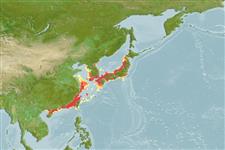>
Eupercaria/misc (Various families in series Eupercaria) >
Sparidae (Porgies)
Etymology: Acanthopagrus: Greek, akantha = thorn + Greek, pagros, a kind of fish (Ref. 45335).
Eponymy: Hermann Schlegel (1804–1884) was a German-born zoologist who spent much of his life in the Netherlands. [...] (Ref. 128868), visit book page.
More on author: Bleeker.
Environment: milieu / climate zone / depth range / distribution range
Ecologia
marinhas; estuarina demersal; intervalo de profundidade 15 - ? m. Subtropical; 43°N - 20°N, 107°W - 143°W
Northwest Pacific: southern Hokkaido, Japan to the southern Korean Peninsula, middle and north coast of the Republic of China and Taiwan. Not occurring in the Ryukyu Islands.
Length at first maturity / Tamanho / Peso / Idade
Maturity: Lm 29.1, range 10 - ? cm
Max length : 50.0 cm SL macho/indeterminado; (Ref. 559); peso máx. Publicado: 3.2 kg (Ref. 40637)
Descrição breve
Chaves de identificação | Morfologia | Morfometria
Espinhos dorsais (total) : 11 - 12; Raios dorsais moles (total) : 11; Espinhos anais: 3; Raios anais moles: 8.
Found in bays, shallow rocky reefs, and in brackish waters (Ref. 41299). Feeds on mollusks and polychaetes. Spawns in the spring and summer months (Ref. 41299). It is parasitised by the monogenean A. spari on the fins and body surface (Ref. 124057).
Sex change occurs at about 5 years of age (Ref. 36558).
Masuda, H., K. Amaoka, C. Araga, T. Uyeno and T. Yoshino, 1984. The fishes of the Japanese Archipelago. Vol. 1. Tokai University Press, Tokyo, Japan. 437 p. (text). (Ref. 559)
Categoria na Lista Vermelha da IUCN (Ref. 130435: Version 2024-1)
Ameaça para o homem
Harmless
Utilização humana
Pescarias: espécies comerciais; Aquacultura: espécies comerciais; peixe desportivo: sim
Ferramentas
Relatórios especiais
Descarregue XML
Fontes da internet
Estimates based on models
Preferred temperature (Ref.
123201): 13.1 - 25.4, mean 23.7 °C (based on 68 cells).
Phylogenetic diversity index (Ref.
82804): PD
50 = 0.5000 [Uniqueness, from 0.5 = low to 2.0 = high].
Bayesian length-weight: a=0.02138 (0.01296 - 0.03528), b=2.99 (2.85 - 3.13), in cm total length, based on LWR estimates for this species & Genus-body shape (Ref.
93245).
Nível Trófico (Ref.
69278): 3.2 ±0.45 se; based on food items.
Resiliência (Ref.
120179): Médio, tempo mínimo de duplicação da população 1,4 - 4,4 anos (tm=2).
Fishing Vulnerability (Ref.
59153): Moderate vulnerability (37 of 100).
Climate Vulnerability (Ref.
125649): Very high vulnerability (81 of 100).
Nutrients (Ref.
124155): Calcium = 85.9 [43.0, 149.5] mg/100g; Iron = 1.07 [0.60, 2.18] mg/100g; Protein = 19.5 [18.3, 20.6] %; Omega3 = 0.279 [0.169, 0.478] g/100g; Selenium = 22.2 [10.4, 45.1] μg/100g; VitaminA = 6.4 [1.9, 21.1] μg/100g; Zinc = 0.786 [0.522, 1.168] mg/100g (wet weight);
